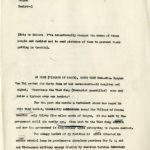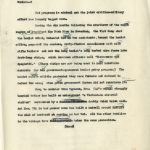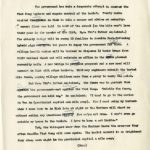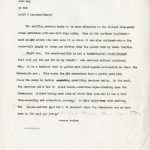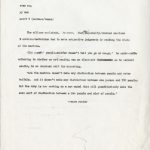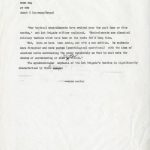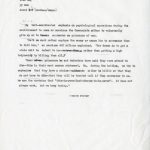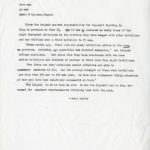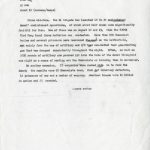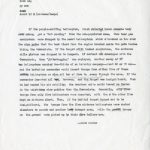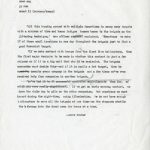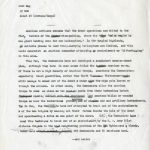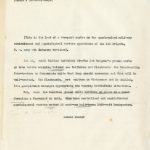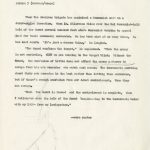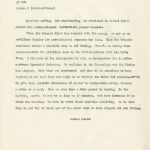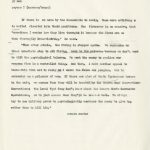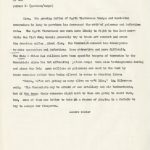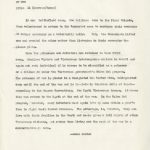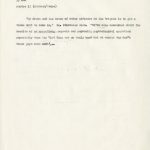1966, September, “Village of Peace”
Beverly Deepe
101 Cong Ly
Saigon
Hamlet–1
(Note to Editor: I’ve intentionally changed the names of these people and decided not to send pictures of them to prevent their getting in trouble).
AN BINH (VILLAGE OF PEACE), SOUTH VIET NAM—Mrs. Nguyen Van Thi patted the dirty face of her seven-month-old daughter and sighed, “Sometimes the Viet Cong (Communist guerrillas) come and raise a typhoon over our hamlet.”
For the past six months a turbulent storm has raged in this tiny hamlet, ironically smllerhmm named the Village of Peace. LocatedSituated only thirty five miles south of Saigon, it was held by the government until six months ago, then lost to the Viet Cong control and now the government is desperately againagain attempting to regain control.
The slieepy hamlet of 43 families is siaut situated in crutic crucial Long An province–a showplace province for U. S. aid and Vietnamese military energy visited by American Defense Secretary Robert McNamara and Nixon Ricmm former Vice President Richard Nixon. Long An is among the seven key provinces around Saigon whichwhere U. S. Ambassador Henry Cabot Lodge has advocatedes the government conentr concentrate their efforts. (More)
Deepe
Hamlet–2
But progress is minimal and the joint civilian-military effort has largely bogged down.
During the six months following the overthrow of the regia regime of President Ngo Dinh Diem in November, the Viet Cong shot the An Binh hamlet chief, beheaded his to two assistants , burned the hamlet office, peppered the austere, dirty-floored schoolhouse with rife rifle bullets and cut the long hamlet’s long barbed wire fence into foot-long strips, which American officers call “Vietnamese sph spaghetti.” (These strips are now being used to reif reinforce concrete for his[the?] government-sponsored hamlet privy program.) The hamlet milita militia pretended they were farmers and refused to defend the area, when goven government forces did not reinforce itthem.
Now, to counter this typhoon, Mrs. Thi‘s stragl straggly bearded father has built an underground “a Vietnamese air-raid shelter” surrounded by a double thick bricmm doubly thick brick wall. And Mrs. Thi in her poorer home has built a mudwall around her ghe the slab of hardwood sh serving as her bed. All the other families in the village have followed thexm taken the same precaution.
(More)
deepe
hamlet–3
“We never saw the Viet Cong,” Mrs. Thi explained cagily evasively. “They came at night, or put guns in our backs when we we were working.” But she admitted the rich farmers–“Those with cemem cement floors and tile-roofed homes”–paid taxes and gave them rice.
But besides the Viet Cong typhoon, Mrs. Thi‘s 66-year-old father explained, stem fungi and leafhopper hx took 90% of the rice crop last year onfrom his 2-acre plot, forcing his son to work on house construction and his daughter to do manual work–carrying 10 gallons of water for half a mile across parched paddy fields for one and a half cents (U. S.). (Actually one piastre.)
“We will be hungry this year,” he said nonchalantly.explained. “But when we get too hungry, we’ll kill a dog to eat.”
Furthermore, Mrs. Thi lamented, she had long ago married a government trooper and bore him four children. But now he’s stationed far away, has hiws own concubine and rarely bothers to give her any money.
For this uneducated, isolated Vietnamese family, the conflict is simply a continuation of the French Indo-China war which began in 1945 and has never stopped. When asked the difference between the government and the Viet Cong guerrillas, the old man replied, “Oh, the two groups have a difference of concepts and invade each others country. But my brain is too small to know the difference.”
When asked about the big nation of China to the north, heMrs. Thi replied, “My mind is close to the market–I have no time to think about China.”
deepe
hamlet 4
The government has made a desperate attempt to counter the Viet Cong typhoon and regain control of the hamlet. Twenty cadre visited thehblx An Binh to take a census and advise on security. A cement floor was laid in half of the school (so the kids wouldn’t lose their pens in the cracks of dkr dirt, Mrs. Thi‘s father explained.) The elderly father will be among 10 families to recieve fast-fattening hybrid pigs and givenwith two years to repay the government for them. A village health worker will be trained to dispense 13 basic drugs from USAID medical chest and will maintain an office in the normm planned community hall. A new bridge is prospose proposed and a new road will connect An Binh with other hamlets. Military engineers rebuilt the barbed wire fence, paying village children more than a penny to carry theeach poles.
But, Mrs. Thi‘s father explained, the fence was to protect them againstfrom the government–not againstfrom the Viet cong. “Outside the fence, the government can kill us,” he explained. “I used to go to the movies in Tan An (provincial capital one mile away). Now I must swing my lantern when I come back to An Binh late at night or the Marines will shoot me without asking any questionsfirst.” Now we’re not free. I can’t even go outside my house to the toilet. I have to keep a pot inside.”
Yet, the villagers know that when the Marines leave the area–as they often do–the Viet Cong will come again. The hamlet council is so frightened they sleep each night in the provincial capital a mile away.
(More)
deepe
hamlet–5
Nine months ago, 219 strategic hamlets were listed on the statistical charts of the province. Then during the November offenseive last year, the Viet Cong systematically wiped them out.
“I could stand on my rooftop and see the Viet Cong burn down all the houses from here southward,” one Tan An resident explained. “But we don’t have that trouble now. The Viet Cong controls them. all.”
In early December three battalions of airborne troops came to summmm hold the areas still under government control, and one. On January 15th the government launched the pacification program designed to clear the area of Viet Cong guerrillas and then to deveop develop social, economic, educational and medical programs to win the hearts and minds of the people.
But progress has been slow. Long An now lists only 15 pro hamlets which under government control–but the s its schedule calls for 30 to be secured. During the next six months $100,00 (repeat U. S.$100,000) will be spent in a massive program inlcuding: free fertilizer, insectico insecticide and rice seed for farmers, two maternity clinics, adult education undervia kerosene lanterns, pig programs, and a wide range of othr other projects.
(More)
deepe
hamlet–6
“Yet we’re getting only 50% of the value out of each bridge we build,” one American observer explained. “The Viet Cong promise the people everything, but give them nothing. the government does alot to ehlp help the people, but does not exploit it or publicize it.”
One of the glaring sym signs of lown government prestige among the people is the government’s inability to recruit militia. The province is already understrength 3,000 paid paramility tr paramilitary troopers. In themmmmm 15 pacified hamlets From the 15 pacified hamlets–obviously lacking many of the younger, able-bodied men–the government scrapped up 66 trainees and sent them to a nearby i militray military center. Three weeks aog ago, in the battle of Go Den, all 66 were when killed when the Viet Cong overran the post.
“We had trouble recruiting these 66 trainees,” one American officer groaned. “How will every convince any more to come to our side.?”
One of the central problems of the pacification ptrogram in Long An is the lack of coordinationbetween Vietnamese military and civilian leaders.. The province chief who commands the pacification plan, does not control the troops necessary to secure the ae area.
“We’ve had so many changes of command and so many changes of troops,” one advisor explained, “we don’t know who’s wh doing what. There’s a general snafu while we’re playing military musical chairs. For Last month, we had a troika ruling the province–with the province chief fighting his own deputy-in-charge-of-security and the commander of the airborne.and hxxx Now the airborne has moved out and we have the Marines in there.”
(More)
deepe
hamlet–7
The civilian cadre, who must be protected by military units in the hamlets, are also “have not been well trained and oriented for the job,” one observer explained. “And there’s a great deal of intertia among the civilian leadership.”
In short, one American observer explained, “We’re“They’re going through the motions doing everything–but their hearts aren’t in it.”
Or, as another explained, “Everyone is on the march and moving–but we’re not going anywhere.”
A
The People Sniffer
Employing Searching Technology
Though it may sound like something out of a Ray Bradbury novel, the U. S. Military employed an ammonia-detecting device to aid in finding Communists troops
zczc sag
yy nnm Long An
sniff 1 (normass/deepe)
TAN AN, SOUTH VIETNAM, SEPTEMBER 23–The “people sniffer” here is becoing a significant military tactical tool for Battlefield detection of large and small Communist units.
The sniffing machine is used daily here and has produced consistently goo dresults in assisting American commanders to find elusive Communist units. But it still is considered far from a quick-fix technological breakthrough for magically winning the war.
Searching for and finding Communist units has been one of the biggest, time-consuming problems of American waging this sub-conventional war; fighting them was a secondary problem. Now, the “people-sniffer” is becoming a standard part of the Allie American el American’san American unit’s electronic inventory for tracking down Communist units, rather than committing Vx Allied units to sweep vast areas before locating them.
–more reuter
zczc sag
yy nnm
sniff 2 (normass/deepe)
Twenty-five miles south of Saigon, Tan An is the provincial capital of Long An province–the gateway leading to the l s lush Mekong Delta–and is the headquarters of the 1st (first) bri Brigade of the U. S. Army 9th Division, which probably more than any other unit has dex developed the battlefield use of the detection device.
The “people-sniffer” looks “like a Hoover vacuum cleaner,” one American officer explained, “but, is, of course, painted Army green” and it funtions in much the same manner. But it is, of course, painted Army green.” The detection machine is placed in a helicopter with two tubes attached to the helicopter’s ski-like Huye’ Huey’s ski-like runners. The bu tubes, like a vacuum cleaner slur s slurping up dust, intakes the air over likely Communist areas. Then, through a complex electronical process, the machine measures the ammonia emitted from human bodies–and from water fu bufaloes, too.–who are either present at the time or were in the previous six hours.
–more reuter
zczc sag
yy nnm
sniff 3 9 (normass/deepe)
The body chimi chemicals are then electronically separated from the air and the amounts are registerd the varying amounts are registered on dials on a zero to five sa scale. Number five is cxa “hot reading” over a likely Communist base or transit area away from village populations. and ism If thex other the “Hot reading” dovetails with other intelligence, indicators or visual aerial or radar indicators, then American reconnaissance or infantry units are sent in to search the area.
The “people-sniffing” helicopter has a dangerous mision–fa flying contour right above the ground or the treetops of scrub-like nipa palms to suck up the air. A number of these helicotpers have been shot at and hit–in fact, them many times the helicopters are hit by Communist gunfire before the “people-sniffer” has time to warntim register that the Communists are there.Present. But, a “hot reading” on the sniffer, plus getting shot at from the ground, is generally enough indication there are enough Communists are in the area for American troops to land for a sweeping. The “people=sniffing” helicopter is always accompanied by four gunships covering gunships which attempt to suppress the Communist fire.
–more reuter
zczc sag
yy nnm
sniff 4 (normass/deepe)
The sniffing machine seems to be more effective in the lowland rice-paddy areas sprinkled with man-tall nipa palms, than in the northern highlands–such as are around Khe Sanh were it wa where it was also employed–where the house-tall jungle te trees are further from the ground trod by human traffic.
“Right now, the people-sniffer is not a technological break-through that will win the war for us by itself,” one American officer explained. “But, it is a tactical tool to gather more intelligence information on where the Communists are . This means the ill commanders have a pretty good idea where the enemy is before commiting committing American units. In the past, the American units had to spend hours–sometimes days–tracking down the Communists without having much idea of where they were and itthis was a very time-consuming and exhaustive process,/ in thisthe waist-deep rice paddies Around Here. Now The people-sniffer just helps to pinpoit where the Communists are or have been in he past six hours.” Before troops Are Committed.”
–more reuter
zczc sag
yy nnm
sniff 5 (normass/deepe)
The officer explained, however, that an especially-trained American t soldier=technician had to make subjective judgements in reading the dials of the machine.
“The people’ people-sniffer doesn’t tell you go or no-go,” he said–reffe referring to whether or not the reading was so clear-cut that Amerim as to warrant sending in an American unit for searching.
“And the machine doesn’t make any distinction between people and water buffalo. And it doesn’t make any distinction between one perseon and 500 people. But the Army is now working on a new model that will quantitatively make the some sort of distinction between a few people and alot of people.”
–more reuter
zczc sag
yy nnm
sniff 6 (normass/deepe)
He added in jest:
“When the Army comes up with a model that will tell us the difference between the goodies and the baddies, then the people sniffer will win the war for us,” he said, referring to differentiating between Communist and non-Communists.
The “people-sniffing” helicopter is usually flown over thinly-populated areas, such as the waste swamplands and nipa palm areas, wh in which prior intelligence information has indicated a likely liklihoo likelihood of Communist movements or presence. If a “hot reading” turns up from a sniffing run, then several more helicopter passes are made to pinpoint the area. Often a smaller, four=seat, light observation helicopter then descends so low that its backblast blows aside the nipa palm leaves for “eyeballing” under under the branches to “eyeball” under the branches for bunkers or foxholes.
–more reuter
Long An
zczc sag
yy nnm
sniff 7 (normass/deepe)
If the Non-populated area looks suspiciou appears visually seems suspicious, a number of ways are often used to end induce Communist troops movement or groundfire. Sometimes, the helicopter gunships employ “reconnaissance by fire” by blasting in rock small rockets–which are not powerful enough to pierce the mud–and concrete Communist bunkers., But might cause troops to move. Or sometimes the the light observation helicopter drops smoke grenades or a hand-sized cannister of E-158 repeat E-158 C/D C/S repeat C/S, a core cross between non-lethal tear gas and vomiting gas. If any siegnfnum significant number of Communist troops are flushed in out by these methods, then American infantry units are quickly heli-dropped to engage them.
(Hank: Tomorrow I’ll cable a sequel to this story on “making the donut” encirclements once a Communist unit is detected by the peoplesniffer. I might filecable one other short piece too txo that I picked up in Long An. I’ll also try to get a mailer off to you. Wh If all is quiet in the Saigon area after that, what do you think of a hasty three of or four day trip to I corps the week beginning September 28? I understand it is heating up quickly?. Regards Bev).
–x end reuter
Donut
US Encirclement Strategy
The following article details how the US military would locate a Communist group and surround them with American artillery and troops, much like a donut around the empty hole.
zczc sag Long An.
yy nnm
dn
donut 2 (normass/deepe)
For the T American troopers who must wade through the waist-deep mud of the upper Mekong Delta, the watchword for them is to keep their eye on the hole–where the Communists are–rather than on the donut formed by U. S. cop companies.
The 1st Brigade of the U. S. 9th Infantry Division has thus far successfully engaged the Communist organized battalions in Long An province–the gateway to the Mekong Delta situated less than 15 miles south of Saigon.–and has secured the southern arc of the capital’s defense. Flying at 1800 feet altitude, American commanders can often look out on3 one Helicopter door of their command helicopters to give orders battlefield orders to t heir units below–and lookpeer out the other chopper door of the helicopter to se the high-rise skyline of Saigon.
–more reuter
zczc sag
yy nnm
donut 3 (normass/deepe)
“Our tactical encirclements have evolved over the past four or five months,” one 1st Brigade officer explained. “Encirclements are classical military tactics which have been on the books for a long time.
“But, here we have been coming out with a new edition. We emphasis more firepower and more psyops (psychological operations) witht he idea of American units surrounding the enemy completely so that he must make the choice of surrendering or else bebeing killed.”
The synchonizedem emphasis of the 1st Brigade’s tactics is significantly characterized by these points:following points.
–more reuter
zczc sag
yy nnm
donut 4 (normass/deepe)
1.First, An Concentrated usage of every availal available electronic, airborne and human means of tracking down Communist units. These means include lo treetop level helicopter reconnaissance, smalla small-unit reconnassi reconnaissiance by aero-riflemen, intellgience intelligence reports from villagers or prisoners, people-sniffing machines that detect human cbody chemicals in non-populated areas, sn and ground radar trae trackings. Once a Communist unit is tracked down, then American infantry coompanies are heli-dropped into the area to encircle it. Int he past, the emphasis was on using American larger American infantry units on search-and-destroy sweeps to find the Communists–and then to fight them. But, the exhaustive, time-consuming job was first finding the elusive Communists, rather than engaging him.
–more reuter
zczc sag
yy nnm
donut 5 (normass/deepe)
2. Second, Once the Communist units have been locat pinpointed, then American commanders begin the encircle–or “making the donut”–by using overwhemlin overwhelmingly superior numbers of American troops to prevent the Communist escape, using helicopter mobility to move th etroops in quickly–using firepower supr superiority of air, artillery and gunships–to instead of ground troops– to fight the Communists. Sometimes as Once, as many as 17 American companies were shuttled in to encircle a reinforced Communist companiesy; sometimes the shuttling of American troops ininto the battlefield encirclement takes as long as 12 hours, and runs is finished during the night-time under the light of illuminating flares.
In the past,
The encirclement alleviates or solves on of the Big Allied problems of the past. “before,“Before, whenever we found the Communists, they were so elusive, they’d just fall through the croks crc cracks, as we used to say, and he’d awalythey’d always escape,” one 1st Brigade officer explained. “So, they we began envolv evolving our encirclement concept to prevent this.”
–more reuter
zczc sag
yy nnm
donut 5 66 (normass/deepe)
3. Third, Well-coordinated emphasis on psychological operations during the encirclement to coax or convince the Communists either to voluntairly give up or to become surrender as prisoners of war.
“We’d xa much rather capture the enemy or cause him to surrender than to kill him,” an American off officer explained. “Our dream is to get a whole unit to defect to us–ratyer than g rather than getting a hight bodycounty by killing them all.“
“Some of ourCommunist prisoners hx and defectors have said they were afraid to die–this is their most common statement. So, during the battles, we try to emphasize that they have a choice–either to either be killed or that they do not have to die— And that they will be treated well if they surrender to us. We use the doctrine that ‘this-is-your-last-chance-to-be-saved”. It does not always work, but we keep trying.”
–more reuter
zczc sag
yy nnm
donut 7 (normass/deepe)
The results of te refinement and coordination of the donut operations has been a n impressive, if not consistently remarkable, kill ratio for the 1st Brigade–generally more than 20 Communists killed and captured for every American killed in action. For the first 19 days of September, the Brigade has killed 303 Communists, captured 50 individuals and 182 weapons. Eighteen Americans were killed in this time period–and 100 wounded. Even with this lop-sided kill-ration, however, x American commanders are unhappy–at that rate, Because roughly sixty or seventy per cent of the American bria brigade fighting in the rice paddies will be killed or wounded in action within a year’s time.
American commanders believe they actually kill even more Communists than they keep count of; only those bodies that are physically recovered are counted; no estimates of others killed are allowed; And Communists who are wounded, but not captured are not tallied;. tThe battlefield bodycount of the brigade is not exaggerated as the American command in Saigon has allowed at times in the past. The commanders admit that being “bodycount oriented” is an inadequate way to measure their work in the province, but that as long as the brigade’s mission is destruction of Communist big-unit formations, it seems to be the single most appropriate index of their effectiveness.
–more reuter
zczc sag
yy nnm
donut 8 (normass/deepe)
Since the brigade assumed responsibility for big-unit fighting in Long An province on June 23, the it has so weakened so badly three of the eight Communist battalions in the province they have merged with other battalions and has whittled down a third battalion to 37 men.
“Three months ago, there were six enemy battalions active in the area, ex province, excluding gua guerrillas and district companies,” one brigade officer explained. “And since then they have reinforced with two more entire battalions and elements of another to total more than eight battalions.
“Now there are four battalions combat effective and able to meanuever maneuver at all. And the average strength of these four battalions are down from 300 men to 150 men each. We have also emphasized taking prisoners of war–and have been relatively successful at that.”
The American brigade wound in time be able to win the big-unit war in Long An–except for constant reinforcements filtering back into the area.
–more reuter
zczc sag
yy nnm
donut 9 (normass/deepe)
“But, now we’re getting a big influx of North Vietnamese in down here,” the officer continued. “Many of the battalions in the province have just come back from Cambodia for refitting, Imxm retraining and replacements. Many of their replacements are now North Vietnamese, where before they were the units were predominantly local Viet Cong. In early June, about 20 per cent of the composition of the units here were North Vietnamese; now the battalions here areHave 50 per cent or more NOrth Vietnamese troops and 30 to 40 per cent of their commanders are North Vietnamese.
“In early June, one North Vietnamese replacement unit came into Long An with 500 men. We caught it theirits first day in the province and hit them four days in a row, killing 300 of them. That battalion was broken up and the 200 survivors were redistributed to the local force battalions.
“Now, the enemy is avoiding contact and is breaking up into platoons; many of our recent contacts are less than platoon strength (roughtly 30 men). When ourbri brigade provesprobes ande finds the Communist units, we smash them–so the alternative for the enemy is to gragment. It becomes increasingly difficult to find and fight him. A week ago, the Communists began to get up and run we when we came into an area. This was unique; usually they hide until night and then sneak away. The last two times, they started jumping in the streams to get away from us and the helicopter gunships would shoot them up.”
–more reuter
zczc sag
yy nnm
donut 10 (normass/deepe)
Since mid-June, the bi brigade has launched 18 to 20 encirclement donut” encirclement operations, of which about half dozen were significantly fruitful for them. One of these was on August 12 and 13, when the 520th Viet Cong local force battalion was contacted. More than 100 Communist bodies and several prisoners were recovered the next on the battlefield, mak mainly from th euse of artillery and C/S tear non-lethal tear gas-vomiting gas that was dropped consistently throughout the night. OFten, as much as 2000 rounds of artillery are pounded iht into the hole of the donut throughout one night as a means of routing out the Communists or inducing them to surrender.
On another occasion, 17 companiesAmericans were rushed into in to form the donut; the results were 93 Communists dead, four def voluntary defectors, 14 prisoners of war and a number of weapons. American losses were 11 killed in action and 23 wounded.
–more reuter
zczc sag
yy nnm
donut 11 (normass/deepe)
The “checkerboard” technique was used by the brigade before arriving in Long An province, while it was operating near the Cambodian border in the non-populated, marshy prairies of the p Plain of Reeds. Then, the bir brigade commander heli-dropped a handful of American troops into each of the one kill one-kilometer grid squares on his map of their area of responsibility. Each small American unit swept bhoir its individual grid square as a thorough means of d finding the Communists.
This technique was later modified in the more diversified terrain of Long An province into a ” an “advanced checkerboard,” which became known as “jitterbugging.” Instead of using infantry troops to sweep each grid square on the made,map, the brigade placed more emephasis on the problem of detecting the Communists in by more sophisticated and syast systematic means.
Each morning the brigade staff scrutinized all thie their rada ground radar and intelligence data from the prviou previous night. Then, it dispatched ten helicopters to these hotspots of Reported Communist Activity. These ten helicopters formed the brigad’ brigade’s Air Cavalry unit and included one poeplep “people-sniffing” helicopter, three light scout helicopters, several armed gunships for protection and four troopcarrying helicopters loaded with their organizAn organic rifle platoon.
–more reuter
zczc sag
yy nnm
donut 12 9 (normass/deepe)
If the “people-sniffing” helicopter, which detecteds human ammonia orde odors, got a “hot reading” from the non-populated area, then tear gas cannisters were dropped by the scout helicopters which o hovered so low over the nipa palms that the back blast from the engine brushed aside the palm leaves hiding the Communists. If the target still looked suspicious, the airborne rifle platoon was dropped in to inspect. If contact was developed with the Communists, then “jitterbugging” was employed. Another covey of 10 ten heliocpters carried two-thirds of an infantry company–about 60 or 70 men–and the battalion commander would insert troops from either five of these helicp helicopters or else all ten of them to sweep through the area. If the commander inserted all ten,ten helicopters [together?] however, and the target was insignificant, then he had wasted his air mobility; the American units could travel no faster in the waist-deep rice paddies than the Communists. Generally, only five troops from only five helicopters were inserted, with the r the other five kept on airborne alert. Then, if the initial target turned out to be insignificant, the troops from the five airborne helicopters were rushed elsewhere to search out another hotp hotstpot area, while the ground troop son the grond were picked up by their five helicopters.
–more reuter
zczc sag
yy nnm
donut 13 (normass/deepe)
“All this hopping around with multiple insertions to sweep many targets with a minimum of time and human fatigue became known to the brigade as the jitterbug technique,” one officer explain explained. “Sometimes we make 17 of these small insertions in one day throughout the brigade just to find a good Communist target.
“If we make contact with troop sfrom the first five helicopters, then the first major decision to be made is whether this contact is just a few snipers or if it is a big unit that should be encircled. The brigade commander must decide this–and if it is really a hot target, then he committe commits every company in the brigade and a few times we’ve even recieved help from companies in another brigade.
“We’ve had 18 to 20 successful encircles encirclements thus far, of which six were really significant. If we get an early morning contact, we have the whole day to pile on the other companies. But soemtiems we must insert during the night-time, using illumintation. We do not have enough helicopters to move all the brigade at one time–so the choppters shuttle the h troops into the donut area for hours at a time.
–more reuter
zczc sag
yy nnm
donut 14 (normass/deepe)
“Then the key questiondecision is to make subsequent insetio insertions far enough away from the contact area to block off the major routes of exit off. But the Communists are not in a neat configuration in neat little nipa palsm. apl palms clumps. If we try a narrow encirclement, other insetio insertions will be tied down and won’t cut the escape routes. Also the use of tactical air and artillery is very tricky in such a small area and our problems of indirect fire are compounded ten fold.
“Generally we insert troops 1000 to 1500 meters from the first contact and then bring in subsequent lifts to plug the gaps. By nightfall, we might have 10 or 11 companies (11 (roughly 1000 six troops) in a circledonut narrowed down. to 600 to 800 meters long by nightfall. Then, during the night, they we pour artillery into the hole of the donut; this is such a this demands such great accuracy that the artillery commander helicopters over the area and personally directs the ar battery fire. During the night we may fire 2000 rounds into the middle of the donut. We havent’ had any American casualties artillery errors yet, but sometimes the rounds come in so close that the artillery fragments scratchnick the American troops. After the all-night bombardment, the troops at dawn begin sweeping the area.”
–more reuter
zczc sag
yy nnm
donut 15 (normass/deepe)
American officers concede that the donut operations are suited to the flat, terrain of the rice-a rice-paddies, where the “diet “delta region is one giant landing zone for our helicopters.” In the jungled highlands, pl duitable places to land troop-carrying helicopters are limited, and this would constrict an American commander attempting an encirclement or “jitterbugging” in this area.
This far, the Communists have not developed a consistent counter-donut plan, although they have in some areas foiled the tagtiem American moves. If there is not a high density of American troops, sometimes the Communists–especially local guerrillas, rather than North Vietnam– Vietnamese–snake still manage to sneak out of the donut x under nipa the nipa palm leaves or through the streams. In other cases, the Communists allow the American troops to come as close as to ysar ye yards from their bunkerline before firing out opening fire; contact with the Americans; any the Americans killed or wounded troops so near the bunkerline prevent maximum use of airplan air and artillery bombardments. Thu So far, the Communists have not attempted to break out of the enirclements of the bre brigade by massing all their forces inside the hole of the donut and spearheading a drive on one point of the donut. But, Last Month, the Communists have D. D. used this technique to break out of an encirclement made by the U. S. Army 101st Airborne Brigade in the nigh neighboring province of Hau Nhi Nghia–and athe bloody, human wave attack exsuied, leavingCommunist assault left 103 Communists and 30 Americans dead.
–end reuter
Psyops
A Battle of Wits
Even the strongest fighter can fear when surrounded by countless enemies, and a voice that pleads loudly enough can break through to the most resilient mind. The following article describes the US encirclement strategy that attempted to force a surrender from the Communists.
zczc sag
yy nnm
psyops 1 (normass/deepe) Long An
(This is the last of a two-part series on the synchonized military encirclement and psychological warfare operations of the 1st Brigade, U.S. Army 9th Infantry division).
TAN AN, SOUTH VIETNAM SEPTEMBER 27–The 1st Brigade’s ground units go into battle carrying bullhor smm bullhorns and flashcards for broadcasting face-to-face to Communist units that they should surrender and thatthey will be well-treated. The flashcards, wrt written in Vietnamese and in English, list pre-planned messages appropriate fro varying battlefield situations.
But, when the American ground units encircle en masse in a donut formationform a donut-shaped encirclement around a Communist uh unit, then more centralized and sophisticated psychological warfare method is used–ax heli-borne 1000-watt loudspeaker.dangling from a helicopter.
==more reuter
zczc sag
yy nnm
psyops 2 (normass/deepe)
The 1st brigade, which concentrates its psychological operations on capturing the Communists, has developed several battlefield techniques. One is called “instand psyops.” (psyopsmm If one Communist prisoner or voluntary defector is taken by the brigade during a battle, he is asked fly over the war zone in a helicopter and broadcast an appeal to his comrades below, telling them he has been will-treated by the American troops. In other cases, “instant psyops” is especially tailored to that th the Communist unit that is encircled; recently, for example, intelligence information indicated the surroundedan encircled unit was low on food and ammunition. The i airborne loudspeaker reminded the Communist troops of this and emphasized the futility of continuing to fight when they were completely encircled without hope of escape.
==more reuter
zczc sag
yy nnm
psyops 3 (normass/deepe)
Another technique is called “psyops with a punch.” The heli-borne loudspeaker messages to the Communists below that the unit surrounded–and that “this-is-your-last-chance” to surrender or defect before the next heavy bombardment by air or artillery bombardment is directed onto their positions.
“We try to fight this war with every angle,” one brigade officer explained.
The brigade’s officer in charge of psychological operations is Fire First Lieutenant James MMM. Kilcrease repeat Kilcrease Junior of Nashville, Tenn. (900 Smiley Street). A young, sensitive Negro who was wounded as a platoon leader last month, he was then assigned to a st the staff position inof the brigade headquarters. He also served in Vietnam in 1963 with the U. S. Special Forces and he speaks a smattering of Vietnamese.
==more reuter
zczc sag
yy nnm
o
psyops x 4 (normass/deepe)
“The hardest part of this war is finding the enemy–not fightiing him,” Lt. Kilcrease explained. “And after finding him, then try to stabilize the enemy–to make him stand still so that we can talk to him without our loudspeakers. If he isn’t interested in listening to us, then we unlease our firepower We try to use our firepower to get a psychological response from him–rather than to kill him. We biv give him the choice of surrendering or dying.”
Thus far, the battlefield s psyops program has had marginal success–but the brigade is continuing to experiment to get better results. Since arriving in Long An province in mid-June, the brigade has recieved elevel eleven voluntary defectors and 300 prisoners, all of them a direct result of psychological operations made during battlefield contacts. Many Communist defectors prefer to turn themselves into Vietnamese government units rather than the brigade, yet roughly 40 per cent of these 127 defectors last month in July were induced to surrender because of the American psyops program.
==more reuter
zczc sag
yy nnm
psyops 5 (normass/deepe)
When the American brigade has encircled a Communist unit in a donut-styledshaped formation, then Lt. Kilcrease flies over the hol Communist-held hole of the donut several hundred feet above the Communist weaponspositions to appeal to t for their surrendo5 surrender. He h as been shot at so many times, he has lost count “It’s just a common thing,” he laughed.
“The donut confines the target,” he explained. “When the enemy is not encircled, then we are talking to the target blind. Without the donut, the confusion of battle does not afford the enemy a chance to escape from his own comrades who watch each other in thier [s-moucells?]. The Communists sometimes shoot their own comrades in the back rather than letting them surrender, but if there’s enough confusion from our donut encirclement, then they can escape.
“When the donut is formed and the encirclement is complete, then I helicopter over the hole of the donut broadcasting to the Communists below with my 1000- from my loudspeaker.”
==more reuter
zczc sag
yy nnm
psyops 6 (normass/deepe)
Speaking softly, but confidently, he continued to detail the o psyops his psyops mission battlefield psyops mission:
“When the brigade first has contact with the enemy, we put on an artillery display for psychological purposes for them Communists. Then the brigade commander orders a complete stop to all firing. There’s no firing from anywhere–from the artillery down to the lowest private with his M-16. Then, I fly over in the helicopters an with an interpreter who is often a former Communist defector. He explains to the Communists why the firing has stopped, that they are surrounded and that it is senseless to keep fighting x and that they can rally to us through the Chieu Hoi program.and thm We give them specific directions of on how to rally–like moving toward a river or a road. Then we give them a time period to decide. In the daytime, maybe it may be as long as 30 minutes, but near darkness it is about ten minutes. We have to watch their reaction carefully, to be sure they do not try to break out of the donut when we have stopped all our firing.”
==more reuter
zczc sag
yy nnm
psyops 7 (normass/deepe)
If there is no move by the Communists to rally, then more artillery x is calle ddirected into their position. The firepower is so massive, that “sometimes I wonder how they live throught it because the fires are so thro thoroughly inter-locking,” he said.
“Then after awhile, the firing is stopped again. We emphasize to our troops an timed immediate stop to all firing, down o the privates becauseBecause we don’t want to tilt the psychological balance. We want the enemy to ralize our weapons fire is a controlled thing. And then I make another appeal to them–this time not to rally us i under the Chieu Hoi program, but to surrender as a prisoner of war. If there are alot of North Vietnamese troops in the unit, we assure them they will be treated byAccording to the Geneva Confe Conventin Conventions, so we just assure them they’ll be treated well. WE always try to use military power to psychologically convince the enemy to give up, rather than to kill him.”
==more reuter
zczc sag
yy nnm
psyops 8 (normass/deepe)
American officers concede tey face many problems in their psychological warfare campaign. Many Communists prefer to mmxmmm would simply fight to their da death–much to the astonish bewilderment of American commanders–rather than surrendering or rallying to Allied units. When they do rally to Allied the Allies, many Communists prefer to come into Vietnamese government outposts and installations, rather than American units–and mahy many of the governmon unisome governments units are none too enthusiastic in welcoming them. Some Communists prefer to rally to Vietnamese government units because of the language barrier with American troops–and also because of Communist propaganda, which as convinced their troopsthem that the American troops are more vicious than the Vietnamese troops in maltreating, killing or torturing them on the spot. American commanders have taken great pans pains to disprove this point; American troops are specifically ordered to make sure the Communist defectors and prisoners are not ru roghed up or shot during ht the battlefield confusions. Sometimes, Commun wounded Communists are given medical treatment on the battlefield so that their comrades can witness it. Even when American troops have had their buddies killed by the Communists, they often butter-up the prisoners and show the prisoners b some kindness by giving them waterk water, cigarco cigarce cigaretes food and gum duringon the battle.field.
==more reuter
zczc sag
yy nnm
psyops 9 (normass/deepe)
Some Communist defectors and prisoners have been amzed that the America expressed amazement that the Americans trea have treated them so kindly with superb medical care, food, boots and clothing. Still, many Communists are afraid to surrender or rally to Allied units, even when faced with death on the battlefield;. Communist cadres have tightened their control over the troops by counter– countering the Allies psyops program. Leaflet Communist cadre say American leaflet drops informin in Communist areas about [winging defectors?] eh the progra Cheiu Hoi program are poisonoused and should NOT repeat NOT be picked up by the Communist troops. After loudspeaker American loudspeaker missions are heard by a Communist unit, the Communist troops are given indoctrination see impromptu indoctrination sessions and hold self-criticism sess meetings because they listened to the “impera “ “imperialistic propaganda.”
==more reuter
zczc sag
yy nnm
psyops 10 (normass/deepe)
Also, the growing influx of North Vietnamese troops and hard-line commanders in Long An province had decreased the rate of prisoner and defection rate. The North Vietnamese are much more likely to fight to the last man–while the Viet Cong locals generally try to break off contact and evade the American units. Alack Also, the Communist command has taken pains to maketerrorism [made?] surrenders and defections less attractive and more difficult. The Chie H Cheiu Hoi ralliers have been specific targets of terrorism by the Communists since the Tet offensive; prison camps were also battlegrounds during and since Tet; some ralliers or prisoners are shot in the back by their comrades rather than being allowed to cross to American lines.
“Hence, we’re not getting as many alive as we’d like,” Lt. Kilcrease said. “The Communists may be afraid of our artillery and air bombardments, but if the troop their comrades right net to them are going t shoo them, too, some of them are better to take th a chance of jumping in a foxhole to try to escape our firepower.
==more reuter
zczc sag
yy nnm
psyops 11 (normass/deepe)
In one battle field case, two ralliers came to the First Brigade, then volunteered to return to the Communist area to convince their comrades to either surrender or r voluntarily rally. But, the Communists killed one and wounded the other rather than listening to their surrender spe please pleas.
Once the prisoners and defectors are returned to base campk camp, American Vietnam and Vietnamese interrogators explain in detail and again ask each individual if he choses to be classified as a prisoner of war or a rallier in under the Vietnamese government’s Cheiu Hoi program. TheA prisoner of war is placed in a designated ba4 barbed wire, well-guarded camp until the end of the war and is treated–by American units at least–according to the Geneva Conventions. For North Vietnamese troops, it means they can return to the North at the end of the war. In the Cheiu Hoi program, however, many defectors must again take up arms within a year’s time to fight their former comrades. The advantage , is, however, they can live with their families in the South and he isthey are given r full rights of other Vietnamese citizens, ot rather than living out the rest of the war in a concentration ca camp.
==more reuter
zczc sag
yy nnm
psyops 12 (normass/deepe)
One North Vietnamese who rallied to the Americans under the Chieu Hoi program later said he wanted to be classified as a prisoner of wa r–he was tired of killing and risking being killed. Also, although there are vague indications, but no specific statements, that North Vietnamese troops fear reprrisals against their families in North Vietnam if it is publicized they have voluntarily defected to the anti-Communist side.
Another psyops experiment prg program tehcniq technique that has been initiated is helicoptering the wives of Viet Cong or ex-Viet Cong over a Communist base and having the woman appealloudspeaker to them through the loudspeaker to surrender. Interrogations have shown that many of the Communist troops are lonely for their families and wives, some of whom have been separated for years. Generally, the wife of the Viet Cong appeals to the fighters to return to their families and thatpromises they will be treated well when they rally.
Last week, a Viet Cong rallier aViet Cong rallier from the Viet Cong and his wife broadcast loudspeaker appeals over the target area where his comrades he had once fought with were hiding out. The next afternoon, four of the Communists from the unit rallied to a Vietnamese government uni. unit;outpost; American officers considered the rallier’s wife more articulate and imaginative in drawing up her appeal for the Communist troops than was her husband who had served with the unit.
==more reuter
zczc sag
yy nnm
psyops 13 (normass/deepe)
“My dream and the dream of other officers in the brigade is to get a whole unit to come in,” Lt. Kilcrease said. “We’re cons concerned about the results of an operation, espacia our psychellg psychological operation especially when the Viet Cong are so badly hurt and we wonder why don’t these guys come out?…over to us?'”
==End Reuter
Read Previous Article: 1966, August, “Medical Interviews”
Read Next Article: 1966, November 10, “Three Sociologists, All Women- One American, One French and One Vietnamese”

